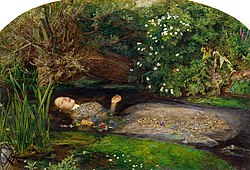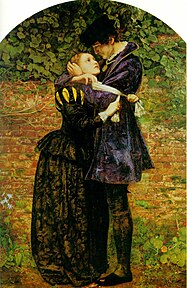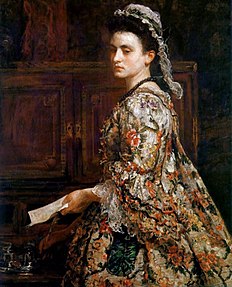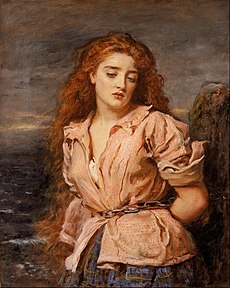John Everett Millais
Royal Academy of Art | |
|---|---|
| Known for | Painting, drawing, printmaking |
| Notable work | Ophelia; Christ in the House of His Parents |
| Movement | Pre-Raphaelite Brotherhood |
| Spouse | |
| Children | 8, including John Guille Millais |
Sir John Everett Millais, 1st Baronet
By the mid-1850s, Millais was moving away from the Pre-Raphaelite style to develop a new form of realism in his art. His later works were enormously successful, making Millais one of the wealthiest artists of his day, but some former admirers including William Morris saw this as a sell-out (Millais notoriously allowed one of his paintings to be used for a sentimental soap advertisement). While these and early 20th-century critics, reading art through the lens of Modernism, viewed much of his later production as wanting, this perspective has changed in recent decades, as his later works have come to be seen in the context of wider changes and advanced tendencies in the broader late nineteenth-century art world, and can now be seen as predictive of the art world of the present.
Millais's personal life has also played a significant role in his reputation. His wife Effie was formerly married to the critic John Ruskin, who had supported Millais's early work. The annulment of the Ruskin marriage and Effie's subsequent marriage to Millais have sometimes been linked to his change of style, but she became a powerful promoter of his work and they worked in concert to secure commissions and expand their social and intellectual circles.
Early life

Millais was born in
His mother's "forceful personality" was the most powerful influence on his early life. She had a keen interest in art and music, and encouraged her son's artistic bent, promoting the relocating of the family to London to help develop contacts at the Royal Academy of Art. He later said "I owe everything to my mother."[5]
In 1840, his artistic talent won him a place at the
Pre-Raphaelite works
Millais's
In paintings such as Ophelia (1851–52) Millais created dense and elaborate pictorial surfaces based on the integration of naturalistic elements. This approach has been described as a kind of "pictorial eco-system". Mariana is a painting that Millais painted in 1850–51 based on the play Measure for Measure by William Shakespeare and the poem of the same name by Alfred, Lord Tennyson, from 1830. In the play, the young Mariana was to be married, but was rejected by her betrothed when her dowry was lost in a shipwreck.
This style was promoted by the critic John Ruskin, who had defended the Pre-Raphaelites against their critics. Millais's friendship with Ruskin introduced him to Ruskin's wife Effie.[6]
Soon after they met, she modelled for his painting
-
Mariana, 1851
-
The Order of Release(1852–53) Tate Britain, London
-
Ophelia (1851–52) Tate Britain, London
-
The Return of the Dove to the Ark (1851)
Ashmolean Museum, Oxford
Family

In 1855, after her marriage to Ruskin was annulled, Effie and John Millais married. He and Effie eventually had eight children: Everett, born in 1856; George, born in 1857; Effie, born in 1858; Mary, born in 1860; Alice, born in 1862; Geoffroy, born in 1863; John in 1865; and Sophie in 1868. Their youngest son,
Effie's younger sister Sophie Gray sat for several pictures by Millais, prompting some speculation about the nature of their apparently fond relationship.[8]
Later works


After his marriage, Millais began to paint in a broader style, which was condemned by Ruskin as "a catastrophe". It has been argued that this change of style resulted from Millais's need to increase his output to support his growing family. Unsympathetic critics such as
Later works, from the 1870s onwards demonstrate Millais's reverence for
Landscapes 1870–1892

His many landscape paintings of this period usually depict difficult or dangerous terrain. The first of these, Chill October (1870, Collection of Andrew Lloyd Webber), was painted in Perth, near his wife's family home. It was the first of the large-scale Scottish landscapes Millais painted periodically throughout his later career. Usually autumnal and often bleakly unpicturesque, they evoke a mood of melancholy and sense of transience that recalls his cycle-of-nature paintings of the later 1850s, especially Autumn Leaves (Manchester Art Gallery) and The Vale of Rest (Tate Britain), though with little or no direct symbolism or human activity to point to their meaning.

In 1870 Millais returned to full landscape pictures, and over the next twenty years painted a number of scenes of Perthshire where he was annually found hunting and fishing from August until late into the autumn each year. Most of these landscapes are autumnal or early winter in season and show bleak, dank, water-fringed bog or moor, loch, and riverside. Millais never returned to "blade by blade"
Illustrations
Millais was also very successful as a book illustrator, notably for the works of
Academic career and baronetage
Millais was elected as an associate member of the Royal Academy of Arts in 1853; a decade later in 1863, he was elected as a full member of the Academy, in which he was a prominent and active participant.
In July 1885, Queen Victoria created him a baronet, of Palace Gate, in the parish of
Last years and death
After the death of Lord Leighton in 1896, Millais was elected President of the Royal Academy. He died later in the same year from throat cancer. He was buried in the crypt of St Paul's Cathedral.[13]
Additionally, between 1881 and 1882, Millais was elected and acted as the president of the Royal Birmingham Society of Artists.[14]
Legacy

When Millais died in 1896, the
Millais's relationship with Ruskin and Effie has been the subject of several dramas, beginning with the silent film The Love of John Ruskin from 1912. There have also been stage and radio plays and an opera. The 2014 film
Gallery
-
A Huguenot on St Bartholomew's Day(1851–52)
-
Mrs Coventry Patmore (Emily Augusta Patmore) (1851) Fitzwilliam Museum
-
The Vale of Rest (1858) Tate Britain, London
-
Bright Eyes (1877), Aberdeen Archives, Gallery & Museums Collection
-
The Black Brunswicker (1860)
-
Parable - The Leaven (c.1860), Aberdeen Archives, Gallery & Museums Collection
-
Parable - The Hidden Treasure (c.1860), Aberdeen Archives, Gallery & Museums Collection
-
Parable - The Pharisee and the Publican (c.1860), Aberdeen Archives, Gallery & Museums Collection
-
The Eve of Saint Agnes (1863)
Royal Collection -
Esther(1865) Private Collection
-
Vanessa(1868)
Liverpool Museums Service -
Chill October (1870), private collection
-
A Flood (1870),
-
The Knight Errant (1870), Tate Britain
-
The Martyr of Solway (circa 1871), Walker Art Gallery
-
An Idyll of 1745. The three female artists models on the right were the sisters Lily Pettigrew [1870-1920]; Hetty Pettigrew [1867-1953] and Rose Pettigrew [1872-1905]
-
Portrait of Effie Millais (1873), Perth Museum and Art Gallery
-
Royal Holloway College
-
National Portrait Gallery (London)
-
National Portrait Gallery (London)
-
The Grey Lady (1888)
Private Collection
See also
Notes and references
- ISBN 978-1-4058-8118-0.
- ISBN 978-0-521-15255-6.
- ^ Lee, Sidney, ed. (1901). . Dictionary of National Biography (1st supplement). London: Smith, Elder & Co.
- ^ cited in Chums annual, 1896, page 213
- ^ J. N. P. Watson, Millais: three generations in nature, art & sport, Sportsman's Press, 1988, p.10
- ISBN 0-394-52432-2.
- ^ Kennedy, Michael (1984). Liner notes to EMI CD CD-EMX-2058
- ^ Suzanne Fagence Cooper (2010) The Model Wife
- ^ "John Everett Millais 1829–1896, Tate Gallery, London". Tate.org.uk. Archived from the original on 6 August 2017. Retrieved 29 January 2014.
- ^ John Everett Millais
- ^ "Image Collections".
- ^ "No. 25490". The London Gazette. 14 July 1885. p. 3239.
- Sinclair, W.p. 469: London; Chapman & Hall, Ltd; 1909.
- ^ The Year's Art. 1904.
- ^ Tate online, February 2002. Retrieved 5 April 2008.
- ^ "Millais – Exhibition at Tate Britain".
- ^ "BBC Drama Production presents Desperate Romantics for BBC Two" (Press release). BBC. 7 August 2008. Retrieved 23 October 2010.
Further reading
| External videos | |
|---|---|
 | |
- Anonymous (1873). "John Everett Millais". Cartoon portraits and biographical sketches of men of the day. Illustrated by Waddy, Frederick. London: Tinsley Brothers. pp. 8–9. Retrieved 28 December 2010.
- Baldry, A. L. Sir John Everett Millais (London, G. Bell & Sons, 1908).
- Barlow, Paul Time Present and Time Past: The Art of John Everett Millais, Ashgate 2005.
- Bennett, Mary. Footnotes to the Millais Exhibition (Walker Art Gallery (Liverpool Bulletin, No 12 1967).
- Bennett, Mary (catalogue) (Walker Art Gallery and Royal Academy catalogue 1967).
- Campbell-Johnston, R (25 September 2007). "Master of Victorian values". Visual Arts. London: The Times. Retrieved 24 September 2007.
- Daly, G (1989). Pre-Raphaelites in love. New York: Ticknor & Fields. ISBN 0-89919-450-8. OCLC: 18463706.
- Eggeling, Dr Joe. Millais and Dunkeld The story of Millais's Landscapes (1985).
- Goldman, Paul. Beyond Decoration: the Illustrations of John Everett Millais. Pinner, Middlesex: Private Libraries Association, 2005
- Lutyens (ed). Millais and the Ruskins 1967.
- Lutyens, M. Letters from John Everett Millais, Bart P.R.A. and William Holman Hunt. O.M. (The Walpole Society, 1972–4).
- Mancoff, D. N. (ed). John Everett Millais beyond the Pre Raphaelite Brotherhood (London and New Haven, 2001).
- Millais, John Guille. The Life and Letters of John Everett Millais. Volume 1, Volume 2 (London: Methuen, 1899).
- National Portrait Gallery catalogue, 1999.
- Rosenfeld, Jason and Alison Smith (Tate Britain catalogue, 2007).
- Rosenfeld, Jason. John Everett Millais. Phaidon Press Ltd., 2012.
- Reynolds, Matthew (24 October 2007). "Millais's high drama and low designs". The Times. London.
- Spielmann, Marion. Notes on Millais Exhibition R.A. 1898.
- F.G. Stephens. Grosvenor 1886 Exhibition of the works of John Everett Millais, Bt (Notes from a catalogue, 1886)
- Warner, Malcolm. The Drawings of John Everett Millais (Arts Council catalogue, 1979).
- Williamson, Audrey (1976). Artists and Writers in Revolt – The Pre-Raphaelites. ISBN 978-0-7153-7262-3.
External links
- 153 artworks by or after John Everett Millais at the Art UK site
- Millais, John Everett. Spring. Lady Lever Art Gallery.
- National Museums Liverpool important Millais collection
- Millais's Ophelia in focus on Tate Online Archived 24 August 2017 at the Wayback Machine
- Tate Shots: Millais's Isabella
- smARThistory: Christ in the House of His Parents and Ophelia – Khan Academy
- Birmingham Museums & Art Gallery's Pre-Raphaelite Online Resource Archived 25 August 2019 at the Wayback Machine includes almost 200 paintings on canvas and works on paper by Millais





















![An Idyll of 1745. The three female artists models on the right were the sisters Lily Pettigrew [1870-1920]; Hetty Pettigrew [1867-1953] and Rose Pettigrew [1872-1905]](http://upload.wikimedia.org/wikipedia/commons/thumb/c/c9/An_Idyll_of_1745_%28Millais%29.jpg/385px-An_Idyll_of_1745_%28Millais%29.jpg)




